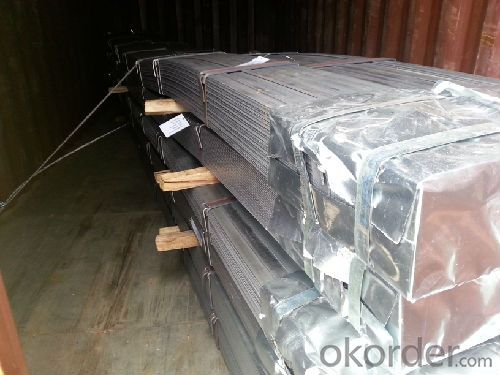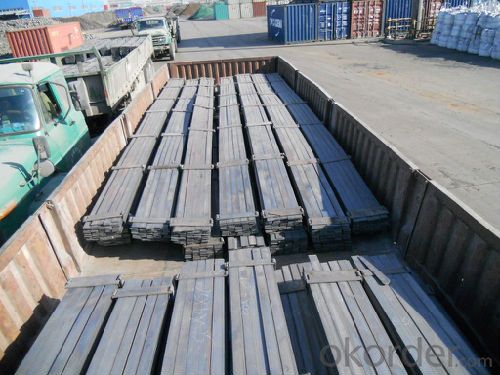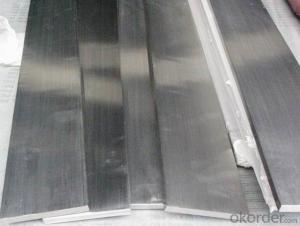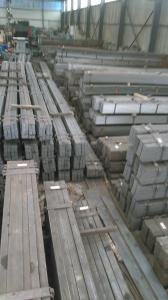Steel Flat Bar JIS Standard Grade SS400B
- Loading Port:
- Tianjin
- Payment Terms:
- TT or LC
- Min Order Qty:
- 50 m.t.
- Supply Capability:
- 10000T m.t./month
OKorder Service Pledge
OKorder Financial Service
You Might Also Like
Product Description:
OKorder is offering Steel Flat Bar JIS Standard Grade SS400B at great prices with worldwide shipping. Our supplier is a world-class manufacturer of steel, with our products utilized the world over. OKorder annually supplies products to African, South American and Asian markets. We provide quotations within 24 hours of receiving an inquiry and guarantee competitive prices.
Product Applications:
Steel Flat Bar JIS Standard Grade SS400B are ideal for structural applications and are widely used in the construction of buildings and bridges, and the manufacturing, petrochemical, and transportation industries.
Product Advantages:
OKorder's Steel Flat Bar JIS Standard Grade SS400B are durable, strong, and wide variety of sizes.
Main Product Features:
· Premium quality
· Prompt delivery & seaworthy packing (30 days after receiving deposit)
· Can be recycled and reused
· Mill test certification
· Professional Service
· Competitive pricing
Product Specifications:
Manufacture: slited
Slitting precision (width) : 0.5 mm or less
Raw material: Q235B, Q345B, Q235-1 b
crosscutting precision (length) : 2 mm or less
Processing: the thickness of 2.0-16 mm;
Shear length: 2000 mm above
Wide degree: 15-1250 - mm;
Leveling precision: 1-2 MM square
Packaging: Export packing, nude packing, bundled
FAQ:
Q1: Why buy Materials & Equipment from OKorder.com?
A1: All products offered byOKorder.com are carefully selected from China's most reliable manufacturing enterprises. Through its ISO certifications, OKorder.com adheres to the highest standards and a commitment to supply chain safety and customer satisfaction.
Q2: How many tons of steel products could be loaded in containers?
A2: Usually the steel products are delivered by bulk vessel because of the large quantity and the freight. However, there are no bulk vessel enter some seaports so that we have to deliver the cargo by containers. The 6m steel product can be loaded in 20FT container, but the quantity is changed according to the size, usually from 18tons to 25tons.
Q3: How soon can we receive the product after purchase?
A3: Within three days of placing an order, we will arrange production. The normal sizes with the normal grade can be produced within one month. The specific shipping date is dependent upon international and government factors, the delivery to international main port about 45-60days.
Images:


- Q:Are steel flat bars suitable for making brackets or supports for HVAC systems?
- Steel flat bars are a suitable choice for creating brackets or supports for HVAC systems. Due to its strength and durability, steel is capable of withstanding the weight and pressure exerted by HVAC units. The stability provided by flat bars allows for easy shaping and bending to meet the specific requirements of the brackets or supports. Moreover, steel exhibits exceptional resistance to corrosion, a crucial characteristic for HVAC systems that frequently encounter diverse environmental conditions. In summary, employing steel flat bars guarantees a dependable and enduring solution for HVAC installations.
- Q:Are steel flat bars suitable for structural support?
- Steel flat bars are a suitable choice for structural support in various applications. Steel is renowned for its strength and durability, making it an excellent material for providing structural support. Particularly, flat bars have a broad range of uses in construction and engineering projects. They can serve as beams or columns to bear heavy loads, act as braces to reinforce structures, or function as connectors to unite different components. Steel flat bars are often favored over alternative materials for structural support due to their exceptional strength-to-weight ratio, resistance to corrosion, and adaptability in design and installation. Nevertheless, it is crucial to ensure that the steel flat bars used meet the specific application's necessary specifications and requirements to guarantee the structure's safety and stability.
- Q:How are steel flat bars manufactured?
- Steel flat bars undergo a process called hot rolling to be manufactured. This process entails heating a steel billet or ingot above its recrystallization temperature, usually around 1,000 to 1,300 degrees Celsius. The heated steel is then passed through a series of rollers to gradually decrease its thickness and shape it into a flat bar. In the hot rolling process, the steel is initially descaled to eliminate any surface impurities and oxides. It then goes through a roughing mill, which consists of multiple sets of large rollers that progressively reduce the steel's thickness. The steel is continuously reheated and passed through the rollers until it reaches the desired thickness. Once the steel has reached the desired thickness through roughing, it moves on to a finishing mill. This mill features smaller rollers that further decrease the thickness of the steel and enhance its surface finish. The steel is rolled back and forth between these rollers until it reaches its final thickness, typically ranging from 3 to 25 millimeters. After the final rolling, the steel flat bar is cooled using water or air to temper it and improve its mechanical properties. It is then cut to the desired length and may undergo additional processes like straightening or surface treatments, depending on its intended use. In summary, the manufacturing process of steel flat bars involves hot rolling, which encompasses descaling, roughing, finishing, cooling, and final processing stages to produce flat bars with various thicknesses and lengths.
- Q:What is the tolerance for thickness in steel flat bars?
- The tolerance for thickness in steel flat bars can vary depending on the specific industry standards and requirements. Generally, the tolerance for thickness in steel flat bars is typically specified in terms of a plus or minus value. For example, a common tolerance for thickness in steel flat bars could be +/- 0.005 inches. This means that the actual thickness of the steel flat bar can deviate from the specified thickness by up to 0.005 inches in either direction. However, it is important to note that the tolerance for thickness can be different for different grades and types of steel flat bars, as well as for different applications. Therefore, it is crucial to consult the relevant specifications and guidelines provided by the manufacturer or industry standards to determine the specific tolerance for thickness in steel flat bars for a particular application.
- Q:Are steel flat bars available in different lengths for packaging purposes?
- Steel flat bars of various lengths are accessible for packaging purposes. They can be tailored to meet the packaging needs of diverse industries, ensuring efficient and secure packaging for a range of products. Whether it involves safeguarding delicate items or stabilizing hefty machinery, steel flat bars in different lengths offer the required support and stability during transportation and storage.
- Q:What are the safety precautions when handling steel flat bars?
- To ensure the well-being of those involved, it is important to take several safety precautions when dealing with steel flat bars. 1. Personal Protective Equipment (PPE) is crucial and should be worn to minimize the risk of injuries. This includes gloves, safety glasses, and steel-toed boots, which protect against cuts, eye injuries, and foot injuries. 2. Proper lifting techniques should be used to avoid strain or back injuries. Lift with your legs, not your back, and seek assistance if the weight is too heavy to handle alone. 3. Securely store and stack steel flat bars to prevent them from falling or toppling over. Use appropriate storage racks or shelves to keep them organized and eliminate potential hazards. 4. Handle steel flat bars with care as they often have sharp edges. Avoid dragging or sliding them across surfaces to prevent injuries. Rounding or deburring the edges can also reduce the risk of cuts. 5. Maintain fire safety by keeping the work area clear of flammable materials and having fire extinguishers available. Avoid using steel flat bars near open flames or other sources of ignition. 6. Proper training is essential for safe handling. Educate yourself and others on the correct techniques and precautions to minimize potential risks. 7. Regularly inspect steel flat bars for damage, such as cracks or corrosion, and replace any damaged bars to prevent accidents. By implementing these safety precautions, individuals can effectively reduce the risks associated with handling steel flat bars and create a safer work environment.
- Q:How do you cut steel flat bars to a specific length?
- To cut steel flat bars to a specific length, you can use various tools such as a hacksaw, circular saw, or angle grinder equipped with a cutting disc suitable for metal. Measure the desired length accurately using a measuring tape or ruler, and mark the cut line on the steel bar. Secure the bar firmly in a vise or clamp to prevent any movement while cutting. Then, carefully follow the marked line and use the selected cutting tool to make a smooth and straight cut through the steel flat bar.
- Q:Can steel flat bars be used for making fencing?
- Yes, steel flat bars can be used for making fencing. They are commonly used in fencing projects due to their durability, strength, and resistance to wear and tear. Steel flat bars provide a sturdy framework for fences and can be easily welded or bolted together to create a secure barrier.
- Q:How to connect the base of the tower crane and the flat steel? How can it be welded and connected?
- How to connect the base of the tower crane and the flat steel?:It can be punched on a flat iron and connected by screws and multiple copper wires
- Q:How do I calculate the weight of a steel flat bar?
- To calculate the weight of a steel flat bar, you need to know its dimensions and the density of steel. The weight can be calculated by multiplying the volume of the bar (length x width x height) by the density of steel, which is typically around 7850 kg/m³.
1. Manufacturer Overview |
|
|---|---|
| Location | |
| Year Established | |
| Annual Output Value | |
| Main Markets | |
| Company Certifications | |
2. Manufacturer Certificates |
|
|---|---|
| a) Certification Name | |
| Range | |
| Reference | |
| Validity Period | |
3. Manufacturer Capability |
|
|---|---|
| a)Trade Capacity | |
| Nearest Port | |
| Export Percentage | |
| No.of Employees in Trade Department | |
| Language Spoken: | |
| b)Factory Information | |
| Factory Size: | |
| No. of Production Lines | |
| Contract Manufacturing | |
| Product Price Range | |
Send your message to us
Steel Flat Bar JIS Standard Grade SS400B
- Loading Port:
- Tianjin
- Payment Terms:
- TT or LC
- Min Order Qty:
- 50 m.t.
- Supply Capability:
- 10000T m.t./month
OKorder Service Pledge
OKorder Financial Service
Similar products
New products
Hot products
Related keywords































